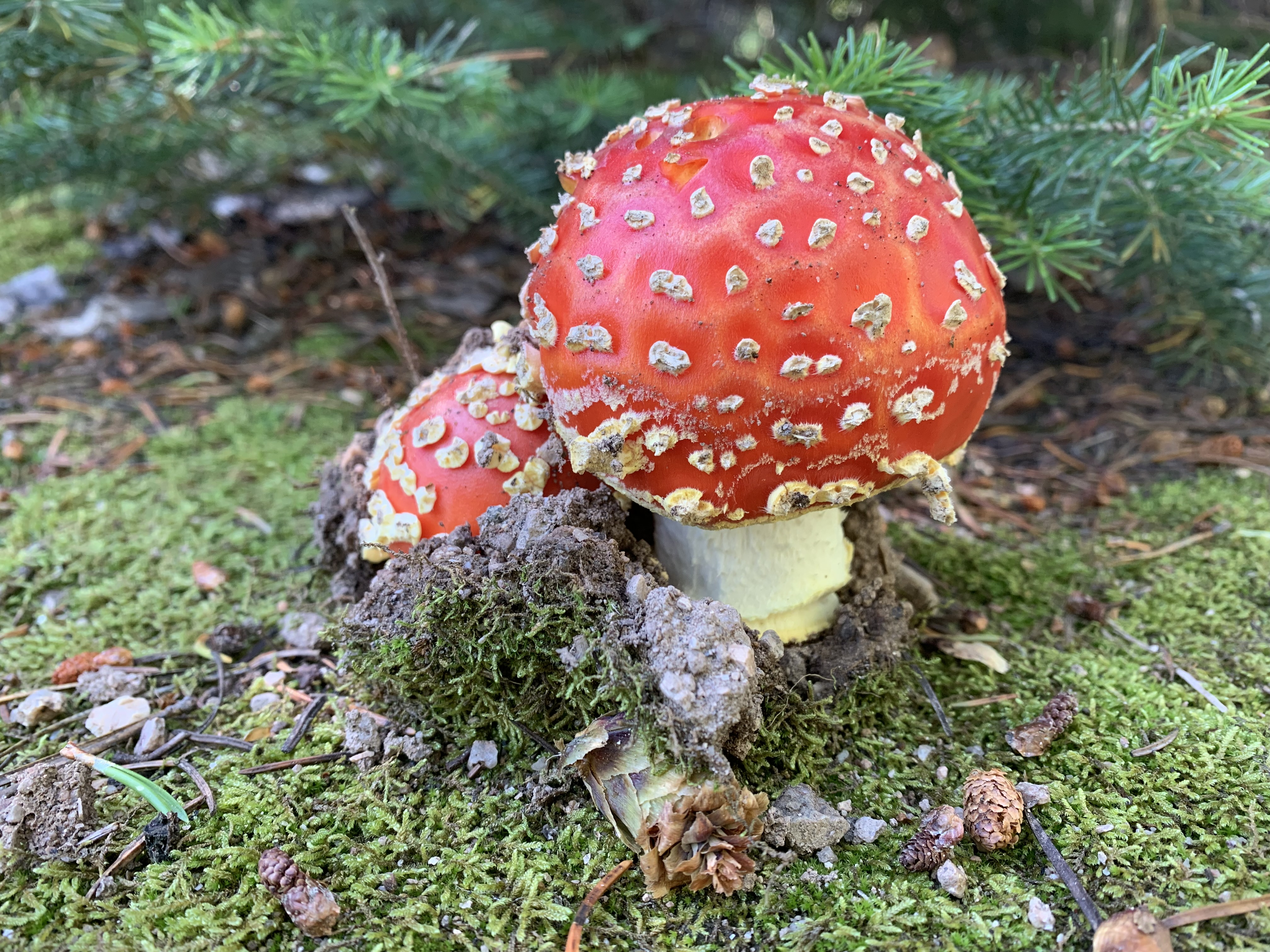About Amanita Muscaria


What Are Amanita Muscaria Mushrooms?
Amanita muscaria—commonly called the fly agaric—is one of the most recognizable mushrooms in the world. With its bright red cap dotted with white spots, it’s the mushroom of fairy tales, Christmas cards, and video games. Yet behind its iconic look lies a fascinating and complex history. This mushroom is psychoactive, but not in the same way as psilocybin mushrooms. First, Amanita muscaria is a microdosing mushroom and is not recommended in larger quantities. At microdose levels, its effects may include dreamy euphoria and relaxation while in larger quantities it may lead to nausea, lack of coordination and intense disorientation. To understand Amanita muscaria more fully, we need to look at its history, chemistry, cultural role, and the effects it has on the human body and mind.
A Brief History
Amanita muscaria grows widely across the Northern Hemisphere, thriving in symbiotic relationships with birch, aspen, pine, and spruce trees. It can be found in Europe, Asia, North America, and has even spread to the Southern Hemisphere through human movement of trees. Historically, it has held a central role in myth, ritual, and medicine.
Shamanic traditions: Among the Sámi people of Northern Europe and the indigenous Siberian groups, Amanita muscaria was reportedly used in spiritual ceremonies. Shamans consumed the mushroom to enter trance states, communicate with spirits, or gain visions.
Religious symbolism: Some scholars have speculated that Amanita muscaria played a role in ancient religious traditions, even suggesting links to the Vedic soma described in Hindu texts or early European myths. Though evidence is debated, the mushroom’s striking appearance and potent effects certainly make it a candidate for mystical reverence.
Folklore and imagery: The fly agaric is a staple in European fairy tales and children’s books, often depicted as the home of gnomes, elves, or forest spirits. It’s thought that Santa Claus’s red-and-white outfit and his association with flying reindeer may have roots in Siberian Amanita traditions.
Chemistry and Active Compounds
Unlike “magic mushrooms” of the Psilocybe genus, which contain psilocybin and psilocin, Amanita muscaria works through a completely different set of chemicals. The primary psychoactive compounds are:
* Muscimol – The main psychoactive agent once ibotenic acid is decarboxylated. Muscimol acts as a GABA agonist, meaning it interacts with the brain’s main inhibitory neurotransmitter. This creates relaxing, dream-like effects, unlike the serotonin-based stimulation of psilocybin mushrooms.
* Ibotenic acid – A compound that partially converts into muscimol through drying or heating--and which is naturally converted into muscimol by the body when consumed in lowe amounts. Consuming larger doses of dried Amanita muscaria can lead to stronger, less predictable, and more unpleasant effects. Ibotenic acid can also be converted to muscimol through a process called decarboxylation (see our page on this).
Microdosing Effects
In recent years, Amanita muscaria has experienced a surge of attention. While long overshadowed by psilocybin mushrooms, it has found new life in modern research. Muscimol’s action on GABA receptors produces experiences that differ markedly from psilocybin trips. While psilocybin often induces open-eyed visuals, a mixing of the senses, and enhanced connectedness, reports of Amanita muscaria’s microdosing effects include improved mood and calmness, reduced anxiety, improved sleep, and (for some people) pain relief.
Effects of Higher Doses
Consuming higher amounts of dried Amanita muscaria mushrooms can lead to a wide spectrum of psychological and bodily sensations and is not recommended. Consumption of larger amounts of Amanita muscaria can result in a real mix of experiences and side effects:
MORE PLEASANT EFFECTS
* Dreamlike states and/or sleepiness followed by vivid dreams – The boundary between waking and dreaming can blur. People often describe the experience as “living inside a dream.” Many report falling asleep after the onset of effects, waking with unusually memorable dreams.
* Euphoria and laughter – Some users feel a childlike giddiness or bursts of laughter.
* Out-of-body sensations – Feelings of floating, flying, or detachment from the body are frequently reported, which may have influenced cultural stories of flight and shamanic journeying.
VARIABLE FFECTS
* Sedation and drowsiness – Many people report feeling as though under the influence of a sedative.
* Disorientation and time loops - Larger doses can result in disorientation or disassociation. Coherent thought may become difficult.
*Visions or hallucinations – Less colorful and intricate than those of psilocybin, but often stranger and more surreal.
* Altered vision and distorted sense of size and reality – Known as “Alice in Wonderland syndrome,” objects or one’s own body may seem much larger or smaller than normal. Light sensitivity can increase.
* Emotional swings – Shifts between euphoria, anxiety, and confusion.
HIGH RISK EFFECTS
* Nausea and stomach cramps: Nausea, vomiting, and excessive salivation.
* Temperature fluctuations – Sweating, chills, or a sense of body heat are common.
* Disassociation and lack of motor control - Misjudging dose can lead to delirium, low blood presure, blackouts, or loss of motor control.
* Muscle twitching or spasms; issues with coordination – Some users experience tremors or jerks. Balance and motor control can be impaired, sometimes producing a staggering gait (hence the old Russian term “mushroom drunk”).
* Dangerous behavior: Because of disorientation, users may stumble, fall, or make unsafe choices.
Conclusion
Amanita muscaria is a mushroom wrapped in mystery, beauty, and contradiction. Its effects are not psychedelic in the traditional sense but instead pull the mind into dreamlike realms of confusion, euphoria, and altered perception. For some cultures, it was a sacred bridge to the spirit world; for others, it was a pest-control tool (hence the name “fly agaric,” as pieces were once soaked in milk to kill flies).
Today, curiosity about this mushroom is growing again. People are exploring its psychoactive effects, its potential therapeutic applications, and its cultural symbolism. But caution remains essential: Amanita muscaria is unpredictable, and its dreamlike gifts can quickly turn overwhelming if consumed in large doses.
